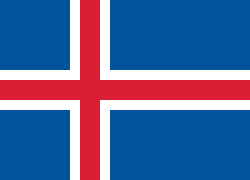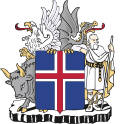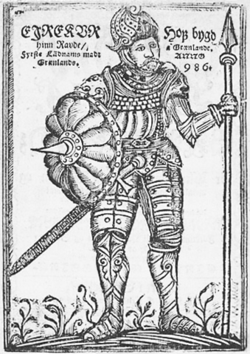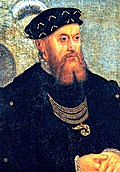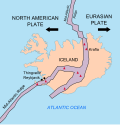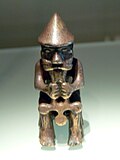Portal:Iceland
The Iceland Portal
Iceland is a Nordic island country between the North Atlantic and Arctic Oceans, on the Mid-Atlantic Ridge between North America and Europe. It is culturally and politically linked with Europe and is the region's westernmost and most sparsely populated country. Its capital and largest city is Reykjavík, which is home to about 36% of the country's roughly 380,000 residents (excluding nearby towns/suburbs, which are separate municipalities). The official language of the country is Icelandic. Iceland is on a rift between tectonic plates, and its geologic activity includes geysers and frequent volcanic eruptions. The interior consists of a volcanic plateau with sand and lava fields, mountains and glaciers, and many glacial rivers flow to the sea through the lowlands. Iceland is warmed by the Gulf Stream and has a temperate climate, despite being a latitude just south of the Arctic Circle. Its latitude and marine influence keep summers chilly, and most of its islands have a polar climate. According to the ancient manuscript Landnámabók, the settlement of Iceland began in 874 AD, when the Norwegian chieftain Ingólfr Arnarson became the island's first permanent settler. In the following centuries, Norwegians, and to a lesser extent other Scandinavians, immigrated to Iceland, bringing with them thralls (i.e., slaves or serfs) of Gaelic origin. The island was governed as an independent commonwealth under the native parliament, the Althing, one of the world's oldest functioning legislative assemblies. After a period of civil strife, Iceland acceded to Norwegian rule in the 13th century. In 1397, Iceland followed Norway's integration into the Kalmar Union along with the kingdoms of Denmark and Sweden, coming under de facto Danish rule upon its dissolution in 1523. The Danish kingdom introduced Lutheranism by force in 1550, and the Treaty of Kiel formally ceded Iceland to Denmark in 1814. Influenced by ideals of nationalism after the French Revolution, Iceland's struggle for independence took form and culminated in the Danish–Icelandic Act of Union in 1918, with the establishment of the Kingdom of Iceland, sharing through a personal union the incumbent monarch of Denmark. During the occupation of Denmark in World War II, Iceland voted overwhelmingly to become a republic in 1944, ending the remaining formal ties to Denmark. Although the Althing was suspended from 1799 to 1845, Iceland nevertheless has a claim to sustaining one of the world's longest-running parliaments. Until the 20th century, Iceland relied largely on subsistence fishing and agriculture. Industrialization of the fisheries and Marshall Plan aid after World War II brought prosperity, and Iceland became one of the world's wealthiest and most developed nations. In 1950, Iceland joined the Council of Europe. In 1994 it became a part of the European Economic Area, further diversifying its economy into sectors such as finance, biotechnology, and manufacturing. (Full article...) Selected article -The Icelandic horse (Icelandic: íslenski hesturinn [ˈistlɛnscɪ ˈhɛstʏrɪn]), or Icelandic, is a breed of horse developed in Iceland. Although the horses are smaller (at times pony-sized) than other breeds, most registries for the Icelandic refer to it as a horse. The breed is long-lived and hardy, owing to the ruggedness of its home country. In their native Iceland they have few afflictions or diseases, thus national laws are in place preventing foreign-born horses from being imported into the country, while exported animals are not permitted to return. In addition to the gaits of walk, trot, and canter/gallop, typical of other horse breeds, many Icelandic horses can also do the tölt (ambling gait) and the flying pace. The only breed of horse in Iceland, the Icelandic is also popular internationally, and sizable populations exist in Europe and North America. The breed is still used for traditional sheepherding work in its native country, as well as for leisure, showing, and racing. Developed from ponies brought to Iceland by Norse settlers in the 9th and 10th centuries, the breed is mentioned in various documents from throughout Icelandic history; an early reference to a named-horse appears in the 12th century. Horses were venerated in Germanic religion, a custom brought to Iceland by the country's earliest settlers. Centuries of selective breeding have developed the Icelandic horse into its modern physical form, with natural selection having also played a role in overall hardiness and disease resistance; the harsh Icelandic climate likely eliminated many weaker horses early on due to exposure and malnourishment, with the strongest passing on their genes. In the 1780s, much of the breed was wiped out in the aftermath of a volcanic eruption at Laki. The first breed society for the Icelandic horse was created in Iceland in 1904, and the breed is represented by organizations in 22 different nations as of 2024[update], organised under a parent association, the International Federation of Icelandic Horse Associations. (Full article...) Selected picture Mývatn is a shallow eutrophic lake situated in an area of active volcanism in the north of Iceland, not far from Krafla volcano. The lake and its surrounding wetlands have an exceptionally rich fauna of waterbirds, especially ducks. The lake was created by a large basaltic lava eruption 2300 years ago, and the surrounding landscape is dominated by volcanic landforms (pictured), including lava pillars and pseudocraters. The effluent river Laxá is known for its rich fishing for Brown Trout and Atlantic Salmon. News
Main topicsSelected biography -Erik Thorvaldsson (c. 950 – c. 1003), known as Erik the Red, was a Norse explorer, described in medieval and Icelandic saga sources as having founded the first European settlement in Greenland. Erik most likely earned the epithet "the Red" due to the color of his hair and beard. According to Icelandic sagas, Erik was born in the Jæren district of Rogaland, Norway, as the son of Thorvald Asvaldsson; to which Thorvald would later be banished from Norway, and would sail west to Iceland with Erik and his family. During Erik's life in Iceland, he married Þjódhild Jorundsdottir and would have four children, with one of Erik's sons being the well-known Icelandic explorer Leif Erikson. Around the year of 982, Erik was exiled from Iceland for three years, during which time he explored Greenland, eventually culminating in his founding of the first successful European settlement on the island. Erik would later die there around 1003 CE during a winter epidemic. (Full article...) Did you know (auto-generated) -

Selected quoteGeneral imagesThe following are images from various Iceland-related articles on Wikipedia.
Selected panorama Öxnadalur is situated in Tröllaskagi, a mountainous peninsula with several peaks reaching over 1000 meters above sea level.
CategoriesThings you can do
Wikipedia in Icelandic
Recognized content
New articlesThis list was generated from these rules. Questions and feedback are always welcome! The search is being run daily with the most recent ~14 days of results. Note: Some articles may not be relevant to this project.
Rules | Match log | Results page (for watching) | Last updated: 2025-06-22 21:11 (UTC) Note: The list display can now be customized by each user. See List display personalization for details.
Web resources
Associated WikimediaThe following Wikimedia Foundation sister projects provide more on this subject:
SourcesDiscover Wikipedia using portals | |||||||||||

